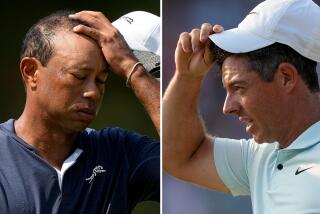THE MINOR OF THE MAJORS : In Eyes of Some, Tournament Doesn’t Stack Up to Masters, British, U.S. Open
- Share via
What a letdown. One week there is the excitement and drama surrounding Olympic synchronized swimming, and the next America is left only with the PGA Championship.
The major golf tournament that nobody cares about except the mother of the guy who wins it every year is about to convene once again on a course no one has ever heard of somewhere lost in the middle of sweaty America.
The 78th dogged, but forgettable, pursuit for the Wanamaker Trophy is billing itself as “the Thoroughbred of Golf’s Major Championships.” Sure. You line up the Masters, the U.S. Open and the British Open, and then you get “the Plowhorse of Golf’s Major Championships.”
The Masters has Amen Corner. The U.S. Open has Baltusrol and Pebble Beach. The British Open has St. Andrews. The PGA usually has the threat of lightning.
“I don’t understand it myself: Why has the PGA gotten such a bad rap?” says Lanny Wadkins, Ryder Cup captain last year and winner of the 1977 PGA. “It has the toughest field of any major, and I know the players embrace it, so I don’t understand it.”
Ignored like the NFL’s Pro Bowl in Hawaii each season, this year’s PGA will be played on a 10-year-old birdie playground in Kentucky sandwiched between the Olympics and the opening of football season, and also will lack the drama surrounding the selection of the Ryder Cup team, which comes every other year after the final major. Why watch this year?
“You look at who has won the majors this year, and there are still a lot of big names out there looking for one last chance to grab one,” Wadkins said. “Are you going to tell me Tom Watson isn’t interested in winning the PGA and completing his personal grand slam?”
Watson, like Arnold Palmer, has never won a PGA Championship, but somehow they still became household names.
“It’s very unfair that some people have relegated this to No. 4 in the list of majors,” said golfer Bob Lohr in an interview with the Orlando Sentinel. “The reason is, the excitement just isn’t quite there to match the others.”
Why so little excitement?
--Obscure venues: For years the PGA of America was criticized for holding its tournament on the course that was willing to bid the highest for its presence. “When Larry Nelson won the 1987 playoff at PGA National Golf Club [in Palm Beach Gardens, Fla.], I don’t think anybody thought it was a wonderful place before or after that tournament,” Wadkins said.
Golf magazine polled 70 Tour players earlier this decade on what courses they hoped never to play again in a major championship. The top five losers were the previous five sites for the PGA Championship.
This year’s tournament will be played at Valhalla Golf Club, a course 25 miles outside Louisville yet to be seen by most of the players. The PGA of America is a partial owner of the club now, and if the tournament succeeds there, it plans to buy controlling interest and make it a regular stop for the PGA Championship.
“It’s a bold move by the PGA,” Wadkins said. “But I like that. There have been great golf courses built in the last 30 years, and contrary to the U.S. Open’s philosophy, there are more areas in the country than stopping in the Northeast nine out of 10 times.
“Great golf courses are the key, however, to making the PGA successful. Finding good golf courses is a positive move, and sometimes you’re going to run into great golf courses in moving around the country. It’s good for the game.”
The Masters is played at Augusta National every year, the British Open has its primary rotation of seven courses, and the U.S. Open toughens the conditions on the toughest courses. The PGA has gone plain Jane to Kemper Lakes (Illinois) and the Atlanta Athletic Club, although it’s scheduled to move to Winged Foot next year and Medinah Country Club in 1999.
“There are some great quality courses,” said John Mahaffey, who won the PGA in 1978, in a published interview. “But when you get back to playing the courses that the Hogans and Sneads won on, that’s when you get the prestige.”
--Too many hacks: Some of the game’s better golfers, who failed to advance to the top 70 in money winnings, were left home on the couch while 40 obscure club pros were given the opportunity to hit balls on the driving range alongside Nicklaus before missing the cut.
The PGA of America, which charges $500 to $600 a year in dues from Class-A golf professionals--teaching pros and golf shop managers--has now reduced the field of 40 club pros to 25 in order to free more invitations for the game’s better players. As a result, the PGA has had the most attractive field the past few years of any major tournament.
“It’s our tournament, basically, but I understand why they don’t want to dilute the field,” said Wayne DeFrancesco, teaching pro at Woodholme Country Club in Pikesville, Md., and the only club pro to make the cut in last year’s PGA Championship at Riviera. “In my opinion, 25 is a good number of club pros. I feel for the guys trying to making a living playing golf. They are the guys who really need the opportunity. Look what it did for John Daly: It turned his whole career around.”
Daly put some pizazz in the PGA after replacing Nick Price at the last minute in the 1991 tournament. The idea of inviting 25 club pros to be Walter Mitty for a day or two is also engaging, but only if one of them makes a magical climb on the leaderboard.
The U.S. Open has qualifiers and amateurs, the Masters pays tribute to history with old-time golfers participating, and the British Open has foreign competitors unknown to American television viewers. The PGA, for all its perceived shortcomings, has had more of the top 100 SONY World Ranking players than the other majors four of the last five years.
“None of the other three majors can compare,” said Jack Nicklaus in a Golf magazine interview. “If you really want to get analytical. . . . I’ll take the PGA every time.”
--Mr. No-Name: The PGA is the best hope for the mediocre player to steal a major and then live off it for the next 15 years. Since 1916, the PGA has been the lone major victory for 29 players, compared to the Masters, which has had only 17. The great players learn how to play Augusta National; the relatively unknown golf courses played in the PGA provide for a more even playing field.
“Check back over the scoring, and I think you will discover that more golfers were in contention longer in the PGA than any of the other three majors,” Nicklaus said.
Bunched together, any one can break free. In the ‘90s, four of the PGA champions have been first-time major winners with Nick Price winning the remaining two titles. Anybody, it seems, can win a PGA Championship; Jeff Sluman triumphed in the 1988 PGA.
--Timing is everything: Nicklaus has suggested moving the PGA Championship ahead of the other three majors every five years.
“By the time the PGA rolls around each year, golf’s public and media have been sated with the first three majors, plus innumerable other tournaments on four American tours--PGA, senior, LPGA and Nike--plus the top overseas events,” Nicklaus said. “There are always at least 13 weeks between New Year’s Day and the beginning of the Masters. . . . If the PGA needs a shot in the arm, I can’t think of a better one.”
Forget it. The PGA isn’t going to leapfrog ahead of the other majors; it is going to plow ahead at Valhalla in the dog days of summer and some guy named Funk will probably win it.
“I know what everybody says about the PGA Championship,” Wadkins said. “But anybody who has won it will tell you just the opposite. Golfers are measured in majors today, and when people start talking about golfers who have won majors, it doesn’t really matter if it’s the U.S. Open, the Masters or the PGA. It’s still a hell of an accomplishment.”
(BEGIN TEXT OF INFOBOX / INFOGRAPHIC)
Tournament at a Glance
* What: The 78th PGA Championship.
* When: Today through Sunday at Valhalla Golf Club in Louisville, Ky. The 10-year-old, 7,144-yard course was designed by Jack Nicklaus and is partially owned by the PGA of America, which is considering assuming total ownership of the layout and making Valhalla a regular part of the PGA Championship rotation.
* Defending champion: Steve Elkington won $360,000 by claiming his first major title in a one-hole playoff with Colin Montgomerie at Riviera Country Club last August.
* Prize money: $2.4 million, $430,000 to the winner.
* TV: Today 9 a.m.-3 p.m. TBS; Friday 9 a.m.-3 p.m. TBS; Saturday 7:30 a.m.-10 a.m. TBS and 10:30 a.m.-3 p.m. Channel 2; Sunday 7:30 a.m.-10 a.m. TBS, 10:30 a.m.-3 p.m. Channel 2.
OTHER COVERAGE
* PGA: To defend his title, Steve Elkington will have to beat the heat and the strongest field of the year. C8
* Top contenders, tee times: C8
How the Majors Compare on TV
PGA CHAMPIONSHIP (CBS)
*--*
Rating Share 1995 4.3 12 1994 4.3 13 1993 5.3 16 1992 3.7 11
*--*
BRITISH OPEN (ABC)
*--*
Rating Share 1996 2.9 11 1995 4.1 14 1994 3.4 13 1993 3.8 14 1992 2.9 11
*--*
MASTERS (CBS)
*--*
Rating Share 1996 7.6 19 1995 7.8 20 1994 6.9 17 1993 6.1 17 1992 5.7 17
*--*
U.S. OPEN (NBC Since ‘95)
*--*
Rating Share 1996 4.7 16 1995 5.0 17 1994 4.7 15 1993 4.8 16 1992 5.7 17
*--*
More to Read
Go beyond the scoreboard
Get the latest on L.A.'s teams in the daily Sports Report newsletter.
You may occasionally receive promotional content from the Los Angeles Times.










